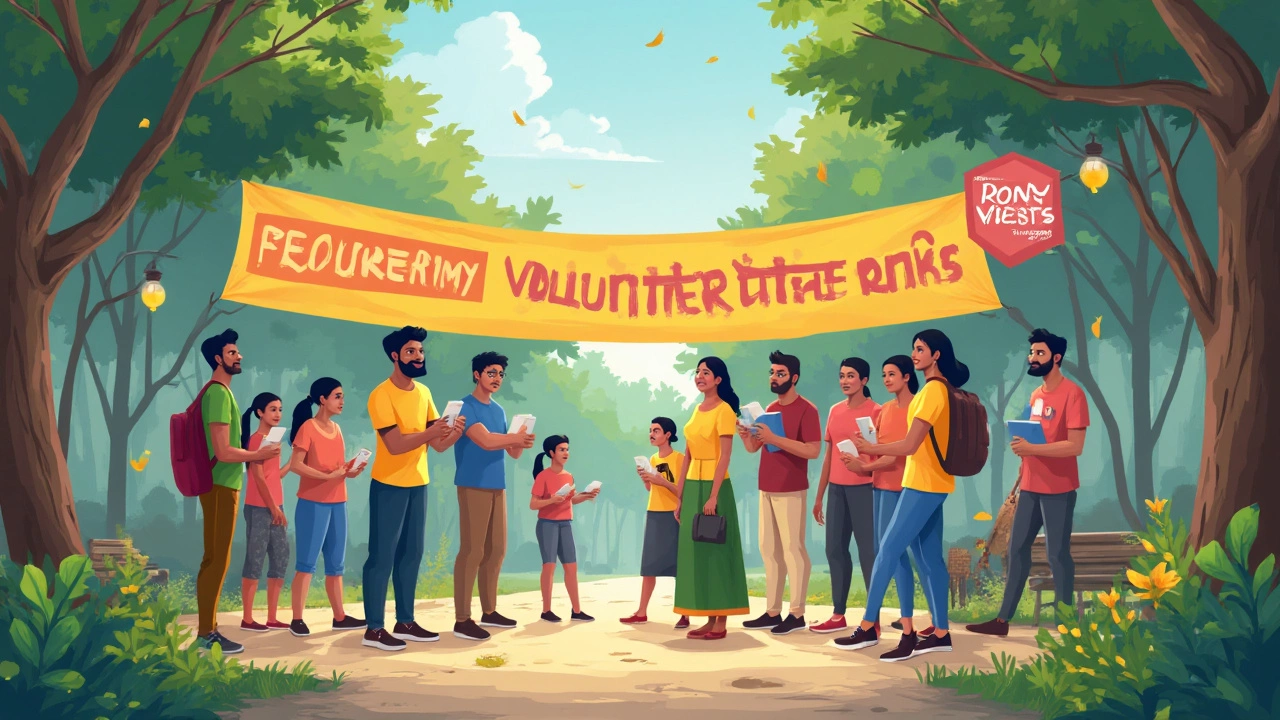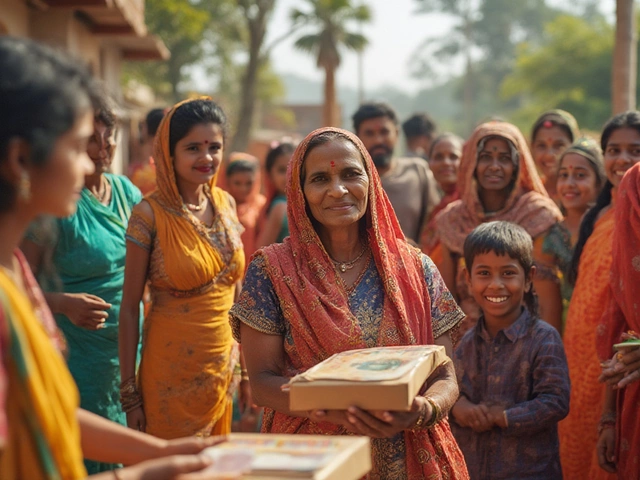You'd think with all the great causes out there, everyone would be eager to sign up and help, right? Turns out, tons of people want to volunteer, but something always gets in the way. Free time is a myth for most of us—between work, kids, and trying to eat dinner before 9 p.m., who has hours left to lend a hand? I remember a promising local food drive last fall, but Zephyr had soccer, Azura needed last-minute science project help, and my inbox was on fire. That week slipped by, just like it does for a lot of parents and busy folks.
Then there's that awkward feeling: Am I even qualified? What if I mess things up or just get in the way? I know friends who've skipped volunteering because they thought you needed special training or super social skills (spoiler: you usually don’t). And when volunteer groups seem a little too cliquey or unwelcoming? That “outsider” vibe can make even the most eager helper pause.
If any of this rings a bell, you're definitely not alone. These aren’t just excuses—they’re legit barriers that get in the way for all kinds of people. Up next, we’ll break down the specifics so you can see where those roadblocks tend to pop up, and, more importantly, what you can actually do about them.
- Time and Scheduling Struggles
- Fears, Doubts, and Feeling Inadequate
- Awkward Experiences and Poor Organization
- Lack of Awareness or Connection
- Practical Tips for Getting Involved
Time and Scheduling Struggles
Let’s be real—most people don’t reject volunteering because they don’t care. The bigger problem is squeezing it into a packed calendar. According to the most recent Bureau of Labor Statistics survey, over half of Americans who don’t volunteer say lack of time is their number one reason. When you add long work hours, family events, and just getting through the basics of the week, volunteering can feel like a luxury.
This problem isn’t just for parents or people with demanding jobs. College students get slammed during finals. Retirees might end up busy with appointments and grandkids. Even folks with flexible remote jobs struggle to block out hours for extra commitments if they aren’t sure what volunteering will look like or require.
Here’s what makes time a challenge for potential volunteers:
- Many opportunities are scheduled during standard work hours, making it impossible for anyone with a 9-to-5 job.
- Some volunteer gigs require multi-hour commitments or long-term signups, which can feel overwhelming if you can only give an hour here and there.
- Last-minute or inconsistent scheduling throws off people who need to coordinate childcare, transportation, or other responsibilities.
I’ve had to skip many fun events at the kids’ school because things popped up last minute at work, or Griffin had to travel. No one likes flaking out, and the stress of having to cancel makes some folks not sign up at all.
A few organizations have gotten creative with this. There are now virtual volunteering options, "micro-volunteering" that lets you help in 20-minute bursts, and some places offer weekend or evening times. If you want to help but only have a little window, look for these flexible options or ask if you can bring the kids along—sometimes organizations are thrilled to have extra hands, even if they’re tiny.
Fears, Doubts, and Feeling Inadequate
This is the big reason a lot of folks avoid signing up for volunteering. People often worry they’ll let someone down or just not be helpful enough. I’ve heard friends say, “I’m not trained for that,” or “What if I mess up?” And honestly, I’ve had the same doubts, especially when the volunteer role sounds important or a bit technical.
A 2022 survey from Points of Light found that about 1 in 3 would-be volunteers hold back because they don’t feel qualified. That means roughly a third of people who care about helping just don’t think they have the skills. It gets worse when volunteer coordinators use jargon or don’t explain the basics, leaving folks feeling lost before they even start.
Let’s not forget social anxiety. Joining a new group or showing up alone fills some people with dread. If you’re shy or not a natural extrovert, walking into a room of strangers can be nerve-wracking. There’s also this myth that you have to be outgoing or a natural “people person” to fit in, but plenty of behind-the-scenes roles need quieter types.
- Worried about doing things wrong? Most places offer quick training and simple tasks for beginners.
- Think you don’t have the right skills? Many organizations value any extra set of hands, even for basic stuff. They’ll teach you as you go.
- Afraid you’ll be awkward or not fit in? Bring a friend if you can, or ask the coordinator what to expect before your first day.
If step-by-step directions help, look for volunteer spots that explain exactly what you’ll do. A clear, friendly welcome from the group can make all the difference. If you're the one setting up opportunities, spell out what newcomers should expect, and maybe pair them with a buddy so they aren’t lost. The more relaxed people feel, the more likely they are to stick around.

Awkward Experiences and Poor Organization
If you've ever shown up to volunteer and spent an hour awkwardly watching a group of regulars do all the work, you know what I'm talking about. Nothing turns people off faster than feeling out of place, unsure what to do, or flat-out ignored. In fact, one study from Volunteer Canada found that almost 30% of would-be volunteers quit after a single confusing or alienating experience.
Sometimes, volunteer coordinators just don't have time (or the system) to onboard new people smoothly. You get there, nobody greets you, and you stand around thinking, "Why did I bother rearranging my whole Saturday for this?" People want a clear role and some structure, but a lot of groups are short-staffed and wing it as they go. Here's what can go wrong:
- No introduction or explanation of what you’re supposed to do.
- Tasks that don’t match what you signed up for (like signing up to plant trees but ending up sorting paperwork).
- Clique-y vibes—existing groups stick together, and newbies get left on the sidelines.
- Poor communication: you never hear when to come back or how you did.
People want to feel useful, not invisible or lost. Jen Love, co-founder of Agents of Good, said,
“Welcoming new volunteers is where a lot of organizations drop the ball. Nobody wants to walk into a room and feel like a stranger at someone else's family dinner.”
When things are disorganized, volunteering becomes an energy drain instead of something that feels rewarding. Just look at these numbers from a 2023 survey by Points of Light:
| Common Volunteer Turn-Off | % Who Quit Because of This |
|---|---|
| Lack of direction | 38% |
| Poor communication | 24% |
| Feeling unwelcome | 19% |
| Task mismatch | 14% |
If you’re running a volunteer event, focus on clear instructions, friendly welcomes, and basic respect for people’s time. And if you’ve had a bad experience, don’t let it sour you on the whole idea. There are well-run volunteering groups out there that do things right—you just have to find them.
Lack of Awareness or Connection
Ever heard someone say, “I’d love to help, but I never know where to start”? That sums up one of the sneakiest hurdles for volunteering: a lot of people simply don’t know what’s out there or don’t feel any real pull toward what they do hear about. A 2023 survey by Points of Light found that 41% of adults in the U.S. said they didn’t volunteer because they weren’t aware of opportunities that matched their interests or skills. That’s not laziness—it’s a communication gap.
If you think about your last week, how many times did you notice an actual, practical call for volunteers? Most folks miss out unless they’re already plugged into a specific group. And if the only volunteering you hear about is at your kid’s school or through work, it might not feel relevant or welcoming. This problem hits even harder in small towns or tight social circles, where causes outside your daily life barely hit your radar.
Here’s a quick peek at some real data about people’s awareness when it comes to volunteer opportunities:
| Reason for Not Volunteering | Percentage (2023, U.S.) |
|---|---|
| Didn't know how to get involved | 41% |
| Didn't feel a personal connection to causes | 27% |
| Never asked by anyone to volunteer | 17% |
So, what helps bridge the gap? A few practical ideas:
- Sign up for local newsletters (your city’s Parks & Rec, public library, or community center usually send updates weekly).
- Ask friends and family directly—most volunteer groups grow fastest just by word of mouth.
- Check out online boards like VolunteerMatch or your local United Way for current listings.
- Follow organizations you like on social media. They post last-minute needs often.
For organizations, using simple language, making sign-ups easy, and showing real stories from volunteers makes a world of difference. If your group wants a hand, you’ve got to ask clearly and often. That’s how you get over the biggest barrier and make volunteering actually feel possible for everyone.

Practical Tips for Getting Involved
Worried volunteering will swallow up your schedule or push you way out of your comfort zone? Let’s make it simpler. Most groups offer shifts as short as an hour, and plenty now let you help from home. In fact, a 2024 survey by VolunteerMatch found that over 54% of new volunteer opportunities can be done virtually. That’s a game changer, whether you’ve got a busy family like mine or just a weird work schedule.
A big hurdle for lots of folks is not knowing where to start. Try checking local libraries, hospitals, or school bulletin boards—they often post super specific needs, from reading with kids to sorting donations. And don’t forget digital options: big sites like VolunteerMatch or Idealist let you filter by time, talent, and even your favorite cause. Plus, many towns now have community Facebook groups with posts about upcoming events and help requests.
If feeling awkward or unskilled is holding you back, remember: organizations don’t expect you to be a pro. They’re happy to train you, and honestly, they just need someone willing to show up (even if it’s just once a month).
- Start small—try a one-off shift or a test event before committing to anything long-term.
- Bring a friend or family member to make it less intimidating (I coaxed Griffin into our first soup kitchen night—having backup made it way less nerve-wracking).
- Pick something that interests you or matches your skills, but don’t overthink it. I once spent an afternoon organizing books at the library, and it was oddly relaxing.
- Ask questions before you sign up. Good groups are always happy to explain what’s expected.
Lots of groups worry they don’t have enough help. Here’s a quick look at how opportunities stack up nationwide:
| Type of Opportunity | Average Hours Needed/Week | Virtual Options? |
|---|---|---|
| Food Pantry | 1-3 | No |
| Tutoring/Mentoring | 2 | Yes |
| Animal Shelter | 2-4 | Rarely |
| Disaster Relief | On-Call | Yes |
| Community Garden | 2 | No |
And don’t sweat the hype around commitment—lots of organizations love “just once in a while” help. So if you want to step up for volunteering, start by looking close to home and keep it low-pressure. Even an hour makes a real difference.





